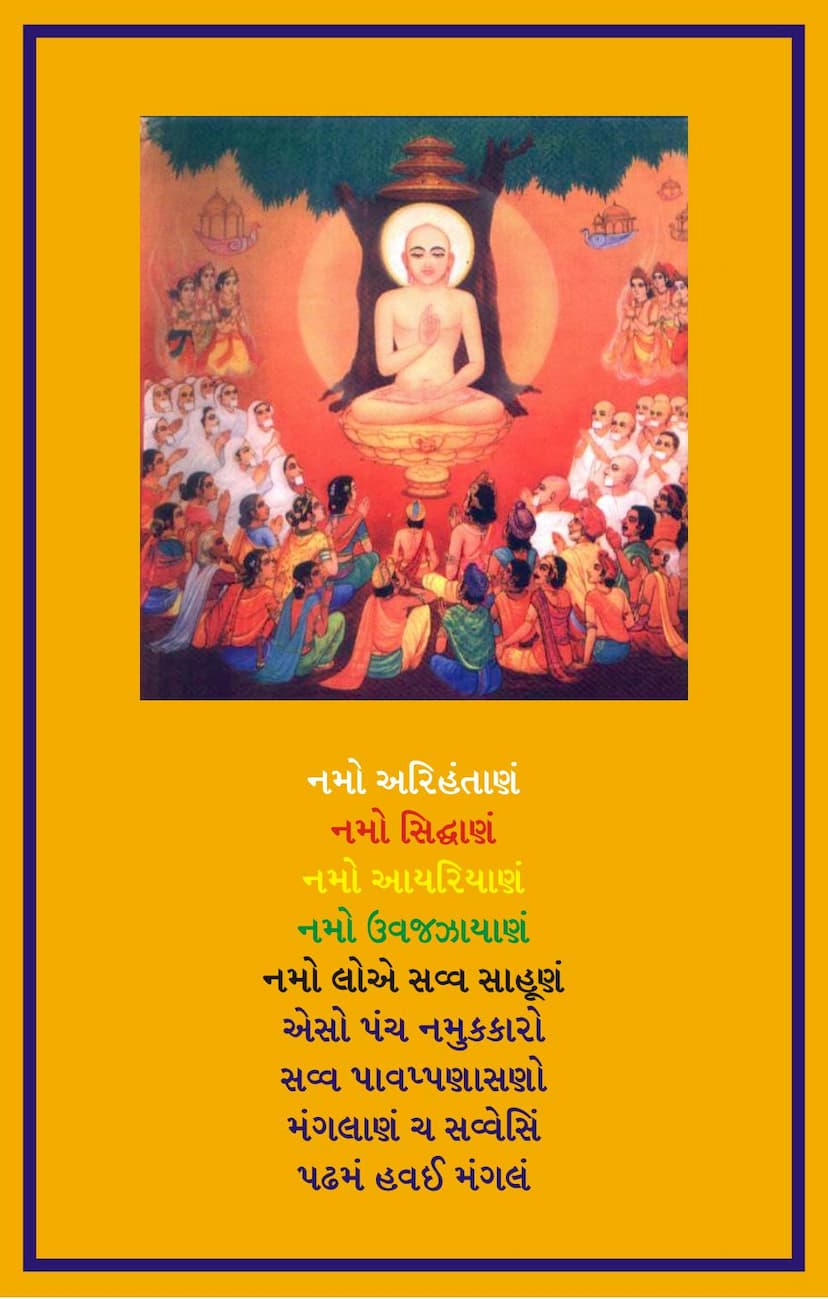Agam 13 Upang 02 Rajprashniya Sutra Part 01 Sthanakvasi
Added to library: September 1, 2025

Summary
The Rajprashniya Sutra is a significant text within the Jain Agama literature, specifically belonging to the Upanga section. This summary covers Part 1 of this Sutra, as presented in the provided text, which is a commentary by Ghasilal Maharaj and published by A B Shwetambar Sthanakvasi Jain Shastroddhar Samiti. The catalog link and publisher information suggest a focus on the Sthanakvasi tradition of Jainism.
Key Aspects of the Provided Text (Pages 1-12):
-
Title and Authorship: The book is titled "Shri Rajprashniya Sutra Part 01" (श्री राजप्रश्नीय सूत्र भाग १), authored by Ghasilal Maharaj (घासीलाल महाराज), who is described with honorific titles like "Jainacharya" and "Jain Dharma Diwakar" (जैनाचार्य-जैनधर्मदिवाकर).
-
Publisher and Edition: It is published by A B Shwetambar Sthanakvasi Jain Shastroddhar Samiti (अ. भा. श्वे. स्था. जैनशास्त्रोद्धारसमिति). The provided text indicates it is a second edition (द्वितीयावृत्तिः).
-
Language and Translation: The text is presented with the original Prakrit (Jain Agam language), along with a Hindi translation and commentary (प्रमेयचन्द्रिका व्याख्या), and also includes a Gujarati translation (हिन्दी-गुर्जर-भाषाऽनुवादसहितम्).
-
Mangalacharan (Invocation): The text begins with traditional Jain invocations: "Namo Arihantanam" (नमो अरिहंताणे), "Namo Siddhanam" (नमो सिद्धाण), etc., acknowledging the five supreme beings in Jainism.
-
Content Outline (Vishayanukramanika - Index of Subjects, Pages 11-12): The index reveals the broad scope of the text. The first part of the Rajprashniya Sutra covers:
- Description of the city of Amalakalpa (आमलकल्पा नगरीका वर्णन).
- The divine being Suryabh (सूर्याभदेव) seeing Jambu-dwipa (जम्बूद्वीप) with his clairvoyant knowledge (अवधिज्ञान).
- Suryabh's visit to Lord Mahavir to pay respects (भगवान् को वन्दना के लिये सूर्याभदेवका आना).
- Description of the divine Samavasarana (देवकृत समवसरण), including purification rituals (भूमिका संमार्गादिका वर्णन).
- Suryabh's declaration of his intention to visit the Lord (भगवान् को वन्दना के लिये सूर्याभदेवकी घोषणा).
- Arrangements for Suryabh's journey to the Lord (भगवान् को वंदना के लिये सूर्याभदेवका गमनकी व्यवस्थाका वर्णन).
- Suryabh paying respects to the Lord and introducing himself (सूर्याभदेवका भगवान् को वंदना करना और अपना परिचय देनेका वर्णन).
- The Lord's discourse to Suryabh about his duties (भगवान् का सूर्याभदेवको स्व कर्तव्यका कथन).
- Suryabh's praise of the Lord's discourse (सूर्याभदेवका भगवान् की पर्युपासनाका कथन).
- The Lord's religious discourse (भगवान ने कही हुई धर्मकथा).
- Suryabh's questions and answers regarding his destiny, etc. (सूर्याभदेवका भवसिद्धि आदि विषयमें प्रश्नोत्तर).
- Suryabh's request to the Lord to demonstrate dramatic arts (नाट्यविधि बतानेके लिये भगवान् के प्रति सूर्याभदेवकी प्रार्थना).
- Description of Suryabh's Samudghata (समुद्घातका वर्णन) and his demonstration of dramatic arts (नाट्यविधिको दिखाना).
- Suryabh's withdrawal of his dramatic arts (नाट्यविधिका संहरण).
- Q&A regarding divine powers (देवऋद्धिके प्रतिसंहरणके विषय प्रश्नोत्तर).
- Description of Suryabh's celestial abode (विमानका वर्णन), palaces (प्रासादावतंसकोंका वर्णन), jewel platforms (पद्मवरवेदिकाका वर्णन), fundamental palaces (मूलप्रासादावतंसकादिकका वर्णन), the assembly hall (सुधर्मसभा आदिका वर्णन), etc.
- Description of the gaming boards (अक्षपाटक और अक्षपाटकमें रही हुई वस्तुओंका वर्णन), stupas (स्तूप का वर्णन), the assembly hall again (सुधर्मसभाका वर्णन), the form of Jina idols (जिन पडिमाके स्वरूप निरूपण), the assembly of souls (उपपातसभा आदिका वर्णन), and Suryabh's contemplation of his rebirth (उपपातके अनन्तर सूर्याभदेवका चिन्तन).
- Suryabh acting according to the instructions of the Samanika Deva (सामानिकदेवके कथनानुसारसे सूर्याभदेवका कार्य करना) and his Indra-Abhishek (इन्द्राभिषेकका वर्णन).
- The beautification of Suryabh's abode by the gods (सूर्याभविमानका देवों द्वारा के सजीकरणका वर्णन), Suryabh's Indra-Abhishek, etc. (सूर्याभदवके इन्द्राभिषेक आदिका वर्णन), Suryabh adorning himself with perfumes and other items (इन्द्राभिषेक आदिका वर्णन), Suryabh wearing ornaments (अलङ्कारधारण करना इत्यादिका वर्णन), Suryabh's activities (कार्यक्रमका वर्णन), and Suryabh's worship of the Jina idols (प्रतिमापूजा चर्चा).
- Gautamswami's question regarding Suryabh's state (सूर्याभदेवकी स्थिति विषयमें गौतमस्वामीका प्रश्न).
-
Astadhyayan (32 Astadhyayan - A List of Impure Times for Study): Pages 6-10 detail a comprehensive list of 32 conditions or times when the study of the original (Moolpath) text is prohibited (अस्वाध्याय). These are categorized into two main groups:
- 10 Aswadhyaya related to the Sky (आकाश संबंधी १० अस्वाध्याय): These include events like meteor showers (उल्कापात), directional fires (दिग्दाह), loud thunder (गर्जाारव), celestial rumblings (निर्घात), lightning (विद्युत), specific celestial lights (चुपक, यक्षालिप्त), and fog (धूमिका कृष्ण, महिका श्वेत), and dust storms (रजोद्घात).
- 10 Aswadhyaya related to the Physical Body (औदारिक शरीर संबंधी १० अस्वाध्याय): These include seeing impure bodily substances like bones, flesh, blood, excreta (मल-मूत्र), being in a cremation ground (श्मशान), eclipses (चंद्रग्रहण, सूर्यग्रहण), royal unrest or war (राजव्यग्रत), death of a prominent person (पतन), and the presence of a dead body (औदारिक शरीर). The text also mentions festivals and specific days (चार महोस्तव और चार प्रतिपदा) when study is prohibited.
-
Commentary Style (Subodini Tika - सुबोधिनी टीका): Pages 13 onwards delve into the commentary by Ghasilal Maharaj, named "Subodhini Tika" (सुबोधिनी टीका). This commentary explains the verses of the Rajprashniya Sutra in detail, often offering philosophical and theological insights within the Jain tradition. For example, on page 14, the commentary discusses the meaning of "Kalilkalilavinaasham" (कलिकलिलविनाशम्) in relation to attachment and aversion (राग-द्वेष) and the eight karmas.
Overall Purpose and Theme:
The Rajprashniya Sutra, as indicated by its table of contents, appears to be a narrative that illustrates Jain philosophy and practice through the interaction between divine beings (Suryabh) and the Tirthankara (Lord Mahavir). It covers cosmology (Jambudwipa, celestial realms), divine conduct, the importance of proper study and adherence to rules (Aswadhyaya), and the path to liberation through adherence to Jain principles. The detailed description of celestial arrangements, the city of Amalakalpa, and the actions of Suryabh and his retinue serve to highlight the opulence and purity associated with enlightened beings and their celestial abodes, offering a rich tapestry for Jain devotees and scholars. The commentary by Ghasilal Maharaj aims to make these complex teachings accessible and understandable.